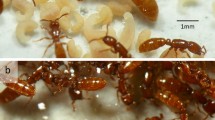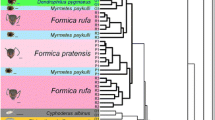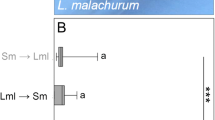Abstract
Larvae of Phengaris (Maculinea) butterflies are adopted by Myrmica workers and are obligate myrmecophiles. Brood recognition by Myrmica rubra workers was tested for concolonial larvae (M. rubra) versus allocolonial larvae (M. rubra and P. nausithous) to assay the mimetic efficiency of P. nausithous. In addition, we tested M. rubra ant colonies from different populations with and without the presence of Phengaris, to test for potential local adaptation in adoption behaviour. We show that M. rubra can distinguish between nest-mate and foreign larvae as well as between P. nausithous and their own larvae. Workers from the allopatric population inspected and rejected more P. nausithous larvae than workers from the sympatric population. This might reflect a local host adaptation in which the social parasite more efficiently mimes its sympatric host ants than allopatric ones.





Similar content being viewed by others
References
Als T.D., Nash D.R. and Boomsma J.J. 2001. Adoption of parasitic Maculinea alcon caterpillars (Lepidoptera: Lycaenidae) by three Myrmica ant species. Anim. Behav. 62: 99-106
Als T.D., Nash D.R. and Boomsma J.J. 2002. Geographical variation in host-ant specifity of the parasitic butterfly Maculinea alcon in Denmark. Ecol. Entomol. 27: 403-414
Araújo M.S., Della Lucia T.M.C., Araújo F.S. and Bento J.M.S. 1996. Discriminacão da prole por operárias companheiras e não companheiras de ninho em Atta sexdens rubropilosa Forel, 1908 (Hymenoptera, Formicidae). Rev. Bras. Entomol. 40: 101-104
Arnaldo P.S., Wynhoff I., Soares P., da Conceição Rodrigues M., Aranha J., Csősz S., Maravalhas E. and Tartally A. 2011. Maculinea alcon exploits Myrmica aloba in Portugal: unusual host ant species of a myrmecophilous butterfly in a peripheral region. J. Insect Cons. 15: 465-467
Barbero F., Thomas J., Bonelli S., Balletto E. and Schönrogge K. 2009a. Queens ants make distinctive sounds are mimicked by a butterfly social parasite. Science 323: 782-785
Barbero F., Thomas J., Bonelli S., Balletto E. and Schönrogge K. 2009b. Acoustical mimicry in a predatory social parasite of ants. J. Exp. Biol. 212: 4084-4090
Bissinger V. and Kolditz O. 2008. Helmholtz Interdisciplinary Graduate School for Environmental Research (HIGRADE), Gaia 2008 1: 71-73
Bonavita-Cougourdan A., Clément J.L. and Lange C. 1989. The role of cuticular hydrocarbons in recognition of larvae by workers of ant Camponotus vagus: changes in the chemical signature in response to social environment (Hymenoptera: Formicidae). Sociobiology 16: 49-74
Bourke A.F.G. and Franks N.R. 1995. Social Evolution in Ants. Princeton Univ. Press, Princeton
Brian M.V. 1975. Larval recognition by workers of the ant Myrmica. Anim. Behav. 23: 745-756
Buczkowski G. and Silverman J. 2005. Context-dependent nestmate discrimination and the effect of action thresholds on exogenous cue recognition in the Argentine ant. Anim. Behav. 69: 741-749
Camargo R.S., Lopes J.F.S. and Forti L.C. 2006. Behavioural responses of workers towards worker-produced male larve and queen-produced worker larvae in Acromyrmex subterraneus brunneus Forel, 1991 (Hym., Formicidae). J. Appl. Entomol. 130: 56-60
Carlin N.F. and Schwartz P.H. 1989. Pre-imaginal experience and nestmate brood recognition in the carpenter ant, Camponotus floridanus. Anim. Behav. 38: 89-95
Czechowsky W., Radchenko A. and Chechowska W 2002. The Ants (Hymenoptera, Formicidae) of Poland: Museum and Institute of Zoology PAS, Warsawa
Dahbi A., Cerdá X., Hefetz A. and Lenoir A. 1996. Social closure, aggressive behaviour, and cuticular hydrocarbon profiles in the polydomous ant Cataglyphis iberica. J. Chem. Ecol. 22: 2173-2186
Dettner K. and Liepert C. 1994. Chemical mimicry and camouflage. Annu. Rev. Entomol. 39: 129-54
De Vries P.J., Cocroft R.B. and Thomas J. 1993. Comparison of acoustical signals in Maculinea butterfly caterpillars and their obligate host Myrmica ants. Biol. J. Linn. Soc. 49: 229-238
Donisthorpe H. StJ. K. 1927. The Guests of British Ants: Their Habits and Life-Histories. Routledge, London
Elmes G.W. and Wardlaw J.C. 1983. A comparison of the effect of a queen upon the development of large hibernated larvae of six species of the genus Myrmica (Hym. Formicidae). Insect. Soc. 30: 134-148
Elmes G.W., Thomas J.A. and Wardlaw J.C. 1991. Larvae of Maculinea rebeli, a large-blue butterfly, and their Myrmica host ants: wild adoption and behaviour in ant nests. J. Zool. 223: 447-460
Elmes G.W., Thomas J.A., Wardlaw J.C., Hochberg M.E., Clarke R.T. and Simcox D.J. 1998. The ecology of Myrmica ants in relation to the conservation of Maculinea butterflies. J. Insect Cons. 2: 67-78
Elmes G.W., Thomas J.A., Munguira M.L. and Fiedler K. 2001. Larvae of lycaenid butterflies that parasitize ant colonies provide exceptions to normal insect growth rules. Biol. J. Linn. Soc. 73: 259-278
Errard C. 1984. Influence des stimulations socials précoces sur l’intégration sociale de l’adulte de Camponotus abdominalis (Hymenoptera: Formicidae). In: Processus d’Acquisition Précoce. Les Communications (De Haro A. and Espadaler X., Eds), Universidad Autónoma de Barcelona and Société Française pour l’Etude du Comportement Animal. Barcelona. pp 71-80
Errard C. and Hefetz A. 1997. Label familiarity and discriminatory ability of ants reared in mixed groups. Insect. Soc. 44: 189-198
Fénéron R. and Jaisson P. 1992. Nestmate-brood recognition among workers of different social status in Ectatomma tuberculatum Olivier (Formicidae, Ponerinae). Behav. Proc. 27: 45-52
Fénéron R. and Jaisson P. 1995 Ontogeny of nestmate brood recognition in a primitive ant, Ectatomma turbercalutum Olivier (Ponerinae). Anim. Behav. 50: 9-14
Foitzik S., De Heer C.J., Hunjan D.N. and Herbers J.M. 2001. Co-evolution in host-parasite system: behavioural strategies of slavemaking ants and their hosts. Proc. R. Soc. Lond. 268: 1139-1146
Foitzik S., Fischer B. and Heinze J. 2003. Arms races between social parasites and their hosts: geographic patterns of manipulation and resistance. Behav. Ecol. 14: 80-88
Fouks B., d′Ettorre P. and Nehring V. 2011. Brood adoption in the leaf-cutting ant Acromyrmex echinatior: adaptation or recognition noise? Insect. Soc. 58: 479-485
Goodloe L.P. and Topoff H. 1987. Pupa acceptance by slaves of the social-parasitic ant Polyergus (Hymenoptera: Formicidae). Psyche 94: 293-302
Hare J.F. and Alloway T.M. 1987. Early learning and brood discrimination in leptothoracine ants (Hymenoptera: Formicidae). Anim. Behav. 35: 1720-1724
Haskins C.P. and Haskins E.F. 1950. Notes on the biology and social behavior of the archaïc ponerine ants of the genera Myrmecia and Promyrmecia. Ann. Entomol. Soc. Am. 43: 461-491
Hölldobler B. and Wilson E.O. 1990. The Ants. Harvard University Press. Cambridge
Human K.G. and Gordon D.M. 1999. Behavioral interactions of the invasive Argentine ant with native ant species. Insect. Soc. 46: 159-163
Isingrini M., Lenoir A. and Jaisson P. 1985. Preimaginal learning as a basis of colony-brood recognition in the ant Cataglyphis cursor. Proc. Natl Acad. Sci. USA 82: 8545-8547
Lahav S., Soroker V., Hefetz A. and Vander Meer R.K. 1999. Direct behavioral evidence for hydrocarbons as ant recognition discriminators. Naturwissenschaften 86: 246-249
Lucas C., Pho D.B., Jallon J.M. and Fresneau D. 2005. Role of cuticular hydrocarbons in the chemical recognition between ant species in the Pachycondyla villosa species complex. J. Insect Physiol. 51: 1148-1157
Meudec M. 1978. Response to and transport of brood by workers of Tapinoma erraticum (Formicidae; Dolichoderinae) during nest disturbance. Behav. Proc. 3: 199-209
Munguria M.J. and Martin J. 1999. Action Plan for Maculinea Butterflies in Europe. Nature and Environment, No. 97. Council of Europe Publishing, Strasbourg. pp 64
Nash D.R. and Boomsma J.J. 2008. Communication between hosts and social parasites. In: Sociobiology of Communication: an Interdisciplinary Approach (d′Ettorre P. and Hughes D.P., Eds), Oxford University Press, Oxford. pp 55-79
Nash D.R., Als T.D., Maile R., Jones G.R. and Boomsma J.J. 2008. A mosaic of chemical co-evolution in a large blue butterfly. Science 319: 88-90
Nash D.R., Als T.D. and Boomsma J.J. 2011. Survival and growth of parasitic Maculinea alcon caterpillars (Lepidoptera, Lycaenidae) in laboratory nests of three Myrmica ant species. Insect. Soc. 58: 391-401
Patricelli D., Witek M., Barbero F., Casacci L.P., Bonelli S. and Balletto E. 2010. Evidence of high larval host ant (Hymenoptera: Formicidae) specificity in the first post-adoption phase for the myrmecophilous butterfly Phengaris (Maculinea) nausithous (Lepidoptera: Lycaenidae). Sociobiology 55: 861-869
Plateaux L. 1985. Adoptions expérimentales de larves entre des fourmis de genres différents (V): larves de Leptothorax nylanderi et éleveuses Myrmica rubra (Hymenoptera, Formicidae). Act. Coll. Insectes Soc. 2: 203–219
Schönrogge K., Gardner M.G., Elmes G.W., Napper E.K.V., Simcox D.J., Wardlaw J.C., Breen J., Barr B., Knapp J.J., Pickett J.A. and Thomas J.A. 2006. Host propagation permits extreme local adaptation in a social parasite of ants. Ecol. Lett. 9: 1032-1040
Settele J. and Kühn E. 2009. Insect conservation. Science 325: 41-42
Stankiewicz A. and Sielezniew M. 2002. Host specificity of Maculinea teleius Bgstr. and M.nausithous Bgstr. (Lepidoptera: Lycaenidae). The new insight. Annals Zool. 52: 403-408
Stuart R.J. and Herbers J.M. 2000. Nest mate recognition in ants with complex colonies: within- and between-population variation. Behav. Ecol. 11: 676-685
Sturgis S.J. and Gordon D.M. 2012. Nestmate recognition in ants (Hymenoptera: Formicidae): a review. Myrmecol. News 16: 101-110
Tartally A. and Varga Z. 2005. Myrmica rubra (Hymenoptera: Formicidae): the first data on host-ant specificity of Maculinea nausithous (Lepidoptera: Lycaenidae) in Hungary. Myrmecol. Nachr. 7: 55-59
Thomas J.A., Elmes G.W., Wardlaw J.C. and Woyciechowski M. 1989. Host specificity among Maculinea butterflies in Myrmica ant nests. Oecologia 79: 452-457
Thomas J.A. and Settele J. 2004. Evolutionary biology: Butterfly mimics of ants. Nature 432: 283-284
Thomas J.A., Simcox D.J. and Clarke R.T. 2009. Successful conservation of a threatened Maculinea butterfly. Science 325: 80-83
Vander Meer R.K. and Morel L. 1998. Nestmate Recognition in Ants. In: Pheromone Communication in Social Insects (Vander Meer R.K., Breed M., Winston M. and Espelie K.E., Eds), Westview Press, Boulder. pp 79-103
Van Zweden J.S. and d′Ettorre P. 2009. Nestmate recognition in social insects and the role of hydrocarbons. In: Insect Hydrocarbons - Biology, Biochemistry, and Chemical Ecology (Blomquist G. and Bagnères A.G., Eds), Cambridge University Press, Cambridge. pp 222-243
Viana A.M.M., Frezard A., Malosse C., Della Lucia T.M.C., Errard C. and Lenoir A. 2001. Colonial recognition of fungus in the fungus-growing ant Acromyrmex subterraneus subterraneus (Hymenoptera: Formicidae). Chemoecology 11: 29-36
Whitehouse M.E.A. and Jaffé K. 1995. Nestmate recognition in the leaf-cutting ant Atta laevigata. Insect. Soc. 42: 157-166
Wilson E.O. 1971. The Insect Societies. Harvard University Press, Cambridge
Witek M., Sliwinska E.B., Skorka P., Nowicki P., Wantuch M., Vrabec V., Settele J. and Woyciechowski M. 2008. Host ant specificity of large blue butterflies Phengaris (Maculinea) (Lepidoptera: Lycaenidae) inhabiting humid grasslands in East-central Europe. Eur. J. Entomol. 105: 871-877
Witek M., Nowicki P., Śliwińska E.B., Skórka P., Settele J., Schönrogge K. and Woyciechowski M. 2010. Local host ant specificity of Phengaris (Maculinea) teleius butterfly, an obligatory social parasite of Myrmica ants. Ecol. Entomol. 35: 557-564
Witek M., Skórka P., Śliwińska E.B., Nowicki P., Moroń D., Settele J. and Woyciechowski M. 2011. Development of parasitic Maculinea teleius (Lepidoptera, Lycaenidae) larvae in laboratory nests for four Myrmica ant host species. Insect. Soc. 58: 403-411
Acknowledgments
This work was supported by HIGRADE scholarship (Bissinger and Kolditz, 2008) and by the CLIMIT project (Settele and Kühn, 2009; Thomas et al., 2009). We thank Jens Kipping (coordinator of the LIFE-project “Pleisse-Aue”) and NABU Sachsen for supporting our science and for the permission to study the Phengaris nausithous population of Altenburg; Sylvia Ritter, Martin Musche, Jonathan Kidner, Bertrand Fouks, Hans-Hinrich Kaatz and Stephan Wolf for their help in statistical analysis and manuscript revision; and all members of Molecular Ecology group of Halle University and the Department of Community Ecology of the UFZ for the stimulating and kind support. We also wish to thank David Nash and an anonymous reviewer for their very helpful comments.
Author information
Authors and Affiliations
Corresponding author
Rights and permissions
About this article
Cite this article
Solazzo, G., Moritz, R.F.A. & Settele, J. Choice behaviour of Myrmica rubra workers between ant larvae and larvae of their Phengaris (Maculinea) nausithous nest parasites. Insect. Soc. 60, 57–64 (2013). https://doi.org/10.1007/s00040-012-0265-3
Received:
Revised:
Accepted:
Published:
Issue Date:
DOI: https://doi.org/10.1007/s00040-012-0265-3




